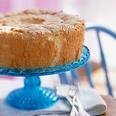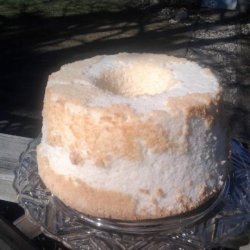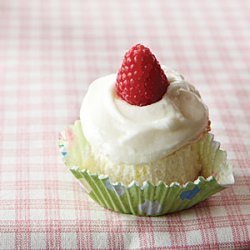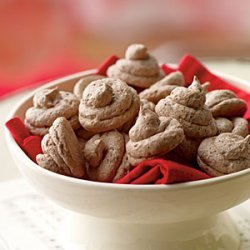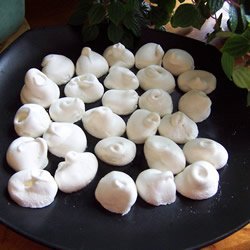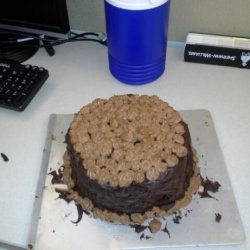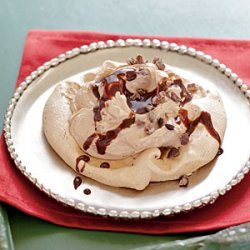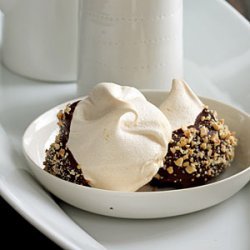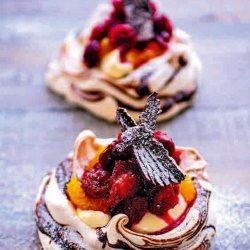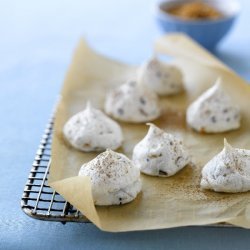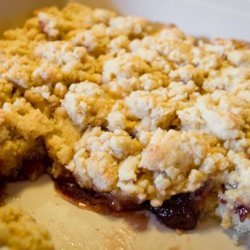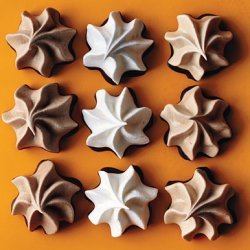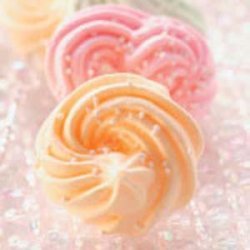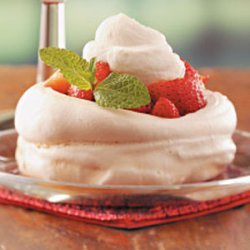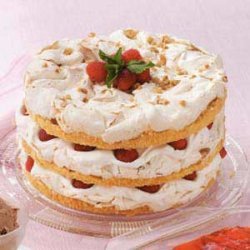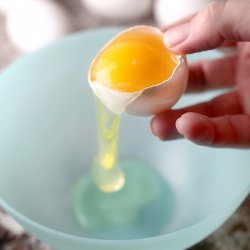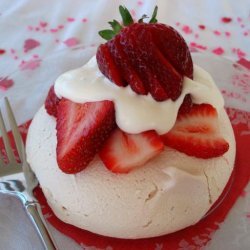Directions:
- If you are using the meringue for a baked pie begin making the meringue at least 20 minutes before the pie is done baking (if using refrigerated eggs as preferred) so that the meringue can be applied to a piping hot filling. Once the meringue is made it should be applied to the pie within 5 minutes or it will begin to lose volume. If you are using the meringue for a refrigerated pie instead of using Cream of Tartar make a cornstarch mixture by combining 1 tablespoon of cornstarch and mixing thoroughly with 1/3 cup of cold water, heat the mixture on the stove in a small saucepan while stirring constantly over low heat until it thickens, then set aside to cool.
- For a meringue with more volume start with refrigerated eggs that are at least several days old. Older egg whites (3-4 days old) create more volume than newer egg whites. Cold eggs separate more easily than temperate eggs because cold egg whites hold together better. Use a clean dry large glass or stainless steel mixing bowl to beat the egg whites in, a small clean dry dish to place the egg in and clean dry beaters to beat the egg whites with. Egg whites will not whip as well if there is any grease or moisture on the bowl, dish or beaters.
- Separate the egg yolks from the egg whites, cracking the egg shell gently in the center of the side by knocking it against the counter. Placing your thumbnails on either side of the crack in the egg shell, gently pull the egg shell halves apart over the dish, transferring the egg yolk from one shell half to the other, allowing the egg white to fall into the dish. Repeat this until all the egg white has fallen into the bowl then set aside the egg yolk. If the egg yolk breaks during this step make certain to remove any traces of yolk (or egg shell) from the egg whites in the dish using an empty egg shell half or a clean dry spoon. The smallest amount of egg yolk in the egg white mixture can cause the egg whites to fail to whip properly. When all the egg white has been placed in the dish and you are certain that the egg white has no yolk or shell in it - transfer the egg whites to the mixing bowl and repeat for all the remaining eggs. Set the egg whites aside.
- If using refrigerated eggs allow 15 to 20 minutes for the egg whites to warm to room temperature. Using either the beaters or a clean dry whisk beat the egg whites until foamy then add the salt and beat well. If you are using the meringue on a pie that will not be refrigerated add the 1/2 teaspoon Cream of Tartar or 1 tablespoon Piping Gel to the egg white mixture and beat until incorporated. Note: once you start the mixing process you need to continue beating without taking any breaks. Set the mixer to medium high and beat the egg whites until they form soft peaks (peaks that droop to one side when lifting the beaters away from the mixture).
- Reduce the mixer speed to medium and begin to gradually beat the sugar into the egg white mixture one tablespoon at a time. When you have finished adding the sugar it is very important to make certain that the sugar is completely dissolved into the mixture. To test for this simply rub a tiny bit of meringue between your fingers - if you feel any grit in the meringue then the sugar has not been completely incorporated - beat for a minute longer and test again. Using extra fine sugar makes this process faster and easier than using table sugar. For a softer meringue use between 1/2 to 3/4 cup of sugar (to prevent weeping use just 1/2 cup), for a harder meringue use between 3/4 to 1 cup of sugar (much more likely to weep). A French Meringue would require 1 cup of sugar. If you are using the meringue with a refrigerated pie begin incorporating the cooled cornstarch mixture into the meringue one tablespoon at a time until you have finished adding the cornstarch mixture. Now add the vanilla extract and beat until it is well blended into the meringue. The beating process is complete when you can hold a spoonful of meringue upside down and none of the mixture falls off (again make certain there is no sugar 'grit' remaining in the meringue). Continue beating the meringue until the peaks are as stiff as you desire. Once the meringue forms stiff peaks (peaks that hold their exact position when the beaters are removed from the mixture) stop beating - do not over beat the mixture.
- Begin placing the meringue on top of the filling (piping hot if the pie was baked). Putting the meringue on a hot filling will seal the meringue underneath and will help to protect the meringue. Make certain that the meringue touches the edges of the pie crust as this will help to prevent shrinking later. Finish spreading the meringue over the pie.
- Bake the meringue in an oven that is preheated to 325 degrees. Bake for 20 to 30 minutes - be careful to watch the meringue closely as it will begin to brown quickly once it nears the end of the baking cycle. Overcooking can cause the meringue to become tough, sweat or burn. If you want a meringue that is harder or more done lower the temperature to between 250 to 300 degrees and bake for a longer period of time. Meringues should be baked until light brown in color and dry to the touch.
- Serving & Storage: Cut a meringue pie using a cold wet knife dipping between cuts in cold water. There are conflicting answers on whether or not baked meringues need to be refrigerated. They are perfectly safe at room temperatures for up to 2 hours. Meringue pies should be stored in air-tight containers and are best eaten within a day or two. If the pie is refrigerated it will eventually weep. Cooked meringue can be stored refrigerated for several days or frozen for up to 3 months. Meringue with higher sugar content is more likely to weep since it is the sugar in the meringue that attracts moisture. Using the cornstarch mixture in making the meringue helps to reduce weeping in refrigerated or frozen meringue pies.
- A final note: sweating or weeping meringue on fairly fresh pies is caused by one or more of the following conditions: over-baking, over-beating, under-beating, high humidity, refrigeration or when the meringue is placed on a cool filling.
Nutrition Facts
| Amount Per 1 Serving | |||
| Calories | 117.9 Kcal (494 kJ) | ||
| Calories from fat | 0 Kcal | ||
| % Daily Value* | |||
| Total Fat | 0g | 0% | |
|---|---|---|---|
| Sodium | 94.08mg | 4% | |
| Potassium | 117.73mg | 3% | |
| Total Carbs | 25.7g | 9% | |
| Sugars | 25.47g | 102% | |
| Protein | 3.63g | 7% | |
| Calcium | 2.7mg | 0% | |
| Amount Per 100 g | |||
| Calories | 198.07 Kcal (829 kJ) | ||
| Calories from fat | 0 Kcal | ||
| % Daily Value* | |||
| Total Fat | 0g | 0% | |
|---|---|---|---|
| Sodium | 158.05mg | 4% | |
| Potassium | 197.78mg | 3% | |
| Total Carbs | 43.17g | 9% | |
| Sugars | 42.78g | 102% | |
| Protein | 6.1g | 7% | |
| Calcium | 4.6mg | 0% | |
* Percent Daily Values are based on a 2000 calorie diet. Your daily values may be higher or lower depending on your calorie needs.
Find out how many calories should you eat.
Get Your Recipe of Health!
Follow RecipeOfHealth on Facebook!


